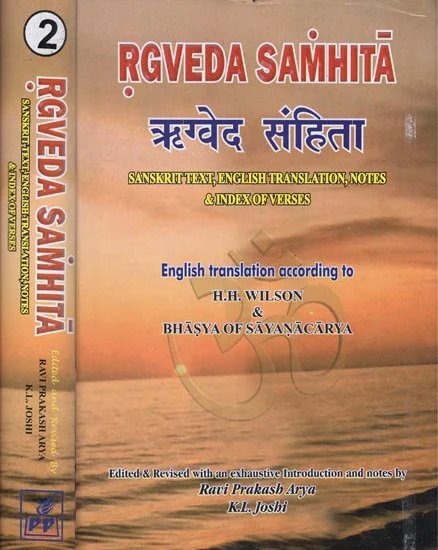Rig Veda (translation and commentary)
by H. H. Wilson | 1866 | 1,999,864 words | ISBN-10: 8171101380 | ISBN-13: 9788171101382
The Rig-Veda, English translation, including the commentary of Sayana and grammatical analysis. The hyms of the Rigveda Samhita represents some of the oldest and complex of Hindu Sanskrit literature. In ten books, these mantras form the core essence of rituals and ceremonies once widely performed throughout ancient India. This edition contains the...
Disclaimer: These are translations of Sanskrit texts and are not necessarily approved by everyone associated with the traditions connected to these texts. Consult the source and original scripture in case of doubt.
Rig Veda 6.6.4
Sanskrit text [Accents, Plain, Transliterated]:
ये ते॑ शु॒क्रास॒: शुच॑यः शुचिष्म॒: क्षां वप॑न्ति॒ विषि॑तासो॒ अश्वा॑: । अध॑ भ्र॒मस्त॑ उर्वि॒या वि भा॑ति या॒तय॑मानो॒ अधि॒ सानु॒ पृश्ने॑: ॥
ये ते शुक्रासः शुचयः शुचिष्मः क्षां वपन्ति विषितासो अश्वाः । अध भ्रमस्त उर्विया वि भाति यातयमानो अधि सानु पृश्नेः ॥
ye te śukrāsaḥ śucayaḥ śuciṣmaḥ kṣāṃ vapanti viṣitāso aśvāḥ | adha bhramas ta urviyā vi bhāti yātayamāno adhi sānu pṛśneḥ ||
English translation:
“Resplendent Agni, your bright rays, horses let loose (from the rein), shear the earth; your (band of flame), mounting above the high-lands of the many-tinted (earth), blazes fiercely.”
Commentary by Sāyaṇa: Ṛgveda-bhāṣya
Shear the earth: kṣām vapanti, muṇḍayanti = shave the earth, the plural nts of which constitute the hair; mounting above the highlands: yātayamāno adhi sānu pṛśneḥ, bhumer-upari parvatāgrādikam prati svakīyam agram vyāpārayan, displaying its own point of flame upon the summit, and the like, of the mountains upon the earh; volcanic eruptions are, perhaps, alluded to
Details:
Ṛṣi (sage/seer): bharadvājo bārhaspatyaḥ [bharadvāja bārhaspatya];Devatā (deity/subject-matter): agniḥ ;
Chandas (meter): nicṛttriṣṭup ;
Svara (tone/note): Swar;
Padapatha [Accents, Plain, Transliterated]:
ये । ते॒ । शु॒क्रासः॑ । शुच॑यः । शु॒चि॒ष्मः॒ । क्षाम् । वप॑न्ति । विऽसि॑तासः । अश्वाः॑ । अध॑ । भ्र॒मः । ते॒ । उ॒र्वि॒या । वि । भा॒ति॒ । या॒तय॑मानः । अधि॑ । सानु॑ । पृश्नेः॑ ॥
ये । ते । शुक्रासः । शुचयः । शुचिष्मः । क्षाम् । वपन्ति । विसितासः । अश्वाः । अध । भ्रमः । ते । उर्विया । वि । भाति । यातयमानः । अधि । सानु । पृश्नेः ॥
ye | te | śukrāsaḥ | śucayaḥ | śuciṣmaḥ | kṣām | vapanti | vi-sitāsaḥ | aśvāḥ | adha | bhramaḥ | te | urviyā | vi | bhāti | yātayamānaḥ | adhi | sānu | pṛśneḥ
Multi-layer Annotation of the Ṛgveda
[Rigveda 6.6.4 English analysis of grammar]
[noun], nominative, plural, masculine
“who; which; yat [pronoun].”
[noun], genitive, singular
“you.”
[noun], nominative, plural, masculine
“bright; clear; white; light; pure.”
[noun], nominative, plural, masculine
“clean; clean; pure; bright; clear; honest; śuci [word]; clear; impeccant.”
[noun], vocative, singular, masculine
“shining.”
[noun], accusative, singular, feminine
“Earth; Earth.”
[verb], plural, Present indikative
“sow; bestrew; strew; scatter.”
[verb noun], nominative, plural
[noun], nominative, plural, masculine
“horse; aśva [word]; Aśva; stallion.”
[adverb]
“then; and; therefore; now.”
[noun], nominative, singular, masculine
“bhrama; dizziness; flare; wandering.”
[noun], genitive, singular
“you.”
[adverb]
“wide; widely.”
[adverb]
“apart; away; away.”
[verb], singular, Present indikative
“look; shine; show; look like; glitter; reflect.”
[verb noun], nominative, singular
“endeavor; settle.”
[adverb]
“on; from; accordingly.”
[noun], accusative, singular, neuter
“tableland; ridge; peak; back; ridge; guru.”
[noun], genitive, singular, feminine
“Pṛśni; beam.”
